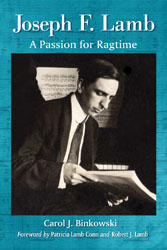| |
Joseph Lamb — The
Humble Ragtime "Sensation"
Featuring Bohemia
Rag (1919) and other Rags by Joseph Lamb
By Ted Tjaden
(originally published June 2006 and
updated periodically)
Joseph
Francis Lamb is rightfully regarded as one of "The
Big Three" composers of classic ragtime music,
along with Scott
Joplin and James Scott. Unlike Joplin
and Scott, however, Lamb outlived the era of
classic ragtime and briefly took part in the
ragtime revival in North America in the late
1950's. Lamb's compositions are highly regarded
for their melodic harmonies and sophistication.
The Library of Congress has a short biography on
Joseph Lamb; in addition, the Library of
Congress also has recently recorded an interview
with Lamb's daughter, Patricia Lamb Conn, in
which she describes her father's music. In
2012, Carol Binkowski published
Joseph F Lamb: A Passion for Ragtime
(McFarland & Company).
Set out
on this page below is more information on Joseph
Lamb, divided into the following topics:
1)
Introduction
2) Life of Joseph Lamb
3) Sheet Music of Joseph
Lamb Compositions
4) Recommended Commercial
Recordings of Joseph Lamb Compositions
5) Bibliography
1) Introduction [top]
That
Joseph Lamb was a white man composing such
intricate ragtime music is not that significant
since there were a number of important white
composers of ragtime (George Botsford, George Cobb
and Percy Wenrich, for example), and it would be
debatable in any event to argue that ragtime
composition is somehow race-dependent. What is
significant about Joseph Lamb is his relatively
late introduction to ragtime (at the age of 18)
and his isolation from the ragtime community other
than a brief meeting and friendship with Scott
Joplin. In addition, unlike many ragtime
composers, it would seem that writing ragtime was
merely a hobby for Joseph Lamb who otherwise
worked full-time in the garment industry and did
relatively little live performing. Lamb also was
able to live a relatively long life (he passed
away at age 72) which meant that he was able to
partake in the ragtime revival, if only briefly;
to this extent, he is alone with Eubie Blake being
the only other original ragtime personality to
have taken part in the renewed interest in ragtime
music.
Jasen and
Tichenor in Rags and Ragtime: A Musical
History (1978: 124) argue
that "Lamb was the consummate ragtime composer,
the genius who possessed the ability to synthesize
the best from all of the Folk, Classic and Popular
ragtime music worlds into stirring works of his
own great originality." Schafer and Riedel (1973: 85) in the Art of
Ragtime: For and Meaning of an Original Black
American Art echo these comments:
.
. . Lamb wrote very lively and completely
organized rags; their thrust not toward
technical or emotional complexity but toward
lyrical flow, transparent vitality, and constant
motion. Rags like "Cottontail Rag," "Reindeer
Rag," and "The Ragtime Nightingale" show a
powerful consistency of lyrical and rhythmic
invention. Lamb's work is fully worthy of Scott
or Joplin, and his rags are as "Negroid" and as
individualized as anything written in ragtime.
2) Life of Joseph Lamb (6 December
1887 – 3 September 1960) [top]
Much has
been written on Joseph Lamb's life (see the bibliography below for more
detailed information). Here are a few fast facts
about his life:
- Lamb
had a brother James and two sisters, Anastasia
and Katharine, from whom Lamb claims to have
learned the piano.
- In
1901, Lamb went to school at St Jerome's College
(now St Jerome's
University) in Berlin (now
Kitchener), Ontario, after death of his
father on October 4, 1900.
- Lamb
took lessons from a priest at the school but
quit after six weeks or so because "the good
father had nothing to offer Joe" (Scotti 1977: 15-16).
- Lamb
is quoted as having said "I never took lessons,
and I can't explain how I happened to be able to
write the rags I did. At about eight I started
to fool around on the piano, but didn't know one
note from another – on the piano or on the
music": from Cassidy
(1961: 4) cited by (Scotti
1977: 15).
- McCarthy (1974: 20)
quotes Amelia Lamb as follows on her husband's
school days in Canada:
Joe
used to laugh when he remembered those days at
the college. He was so homesick that he wrote
his mother and told her that if she didn't
send him the fare home, he'd walk to New
Jersey. I'm surprised he didn't ... he was so
strong-willed.
- In
addition, Amelia mentions that Lamb grew tired
of eating sauerkraut, a regular staple in
Kitchener, Ontario, which was (and remains) a
major centre for German immigrants (and home of
Schneiders,
a major sausage and food producer founded in
1890 in Kitchener). Amelia Lamb also recounts in
that article a story of how Lamb broke his nose
while a student in Canada:
Apparently
in those days, the boys used to have to go
without butter once a week but it was the
custom that everyone took turns buying some
on those days. One day, Joe was running back
to school with the butter when he ran right
into a brick wall and broke his nose.
- Lamb
stayed in Canada in school likely to around 1904
(when he would have been 17 years old) since he
had been accepted at the Stevens Institute of
Technology in New Jersey for an engineering
course in 1904 (although he did not attend
there): Scotti
(1977:19).
- According
to Morriss (1959), in
1907, Lamb walked into the offices of HH
Sparks in Toronto and sold Celestine Waltzes
(below) for $5, since
according to Lamb, "[h]e generally sold his
compositions for anything between $25 and $50
because he wanted to see them in print." Scotti (1977: 73)
confirms the $5 fee for the sale of Celestine
Waltzes. The 1907 date suggested by
Morriss would seem, however, to be in error
since Lamb most likely left Canada around 1904
and there is no evidence that he returned to
Toronto, and it would seem unlikely that he
would return to Toronto to "walk into the
offices" of HH Sparks in 1907. More likely than
not, Lamb made visits to Toronto and to Sparks
while he was resident in Berlin (Kitchener).
Most scholars agree that most if not all of the
Lamb pieces published with Sparks in Toronto
were written by Lamb while he was resident in
Canada and that publication was delayed by
Sparks. Most of the early pieces by Lamb
published by Sparks are extremely rare and hard
to locate; for a listing of these pieces, see below.
- Scotti (1977: 73) quotes
a letter written by Lamb to a friend in which
Lamb describes his relationship with Sparks, a
relationship that was more of a friendship than
a business relationship:
You
know that my first compositions were published
by Harry H Sparks of Toronto. Well, he
published several before I even met him. On
one of my vacations after leaving college my
first thing was to meet him. He invited
me to his home to meet his family and have
dinner with them. As soon as we got in the
house his wife was there to greet us. Here's
the exact wording of his introduction of his
wife to me: "This is my wife and Sweetheart."
It was so unusual I shall never forget it. He
was not a newlywed – he had children going to
school. From observation then as well as in
later years they lived the kind of life
together that you would expect from an
introduction like that.
- In
Lamb's compositions published by HH Sparks in
Toronto it appears that Sparks used the spelling
of "Josef" for Lamb's first name, a practice not
realized for any other (American) publications.
I could find no specific discussion of this
issue in the literature on Lamb. I would
speculate that one possible reason for using
"Josef" on the Spark publications was perhaps
due to the German influence of living in Berlin
(Kitchener), Ontario, with "Josef" being a
Germanic spelling of "Joseph" since Lamb, as an
Irish Catholic, appeared to have used "Joseph"
on all other publications.
- Pseudonyms:
not widely known is the possibility that Lamb
used the pseudonyms of "Harry Moore" and "Earl
West" (and "Gordon Hurst" as publisher of Love
in Absence, below).
Scotti (1977:55-56)
recounts a December 28, 1975, interview he had
with Amelia Lamb to confirm the use of these
pseudonyms for some of the compositions
published in Canada with HH Sparks (and for Love
in Absence). The reason for using
pseudonyms for the Sparks publication is not
that unusual. Many ragtime publishers would use
pseudonyms for their composers to give the
impression that they had more composers under
contract than they actually did.
- After
graduating from St Jerome's College in 1904,
Lamb returned home and went to work for a dry
good store in New York; he was an avid purchaser
of sheet music from Gimbel's and Macy's where
sheet music was discounted on Saturdays to seven
or eight cents each (Scotti
1977: 35).
- Lamb
visited his brother in California in 1906 (Scotti 1977:36).
- Lamb
formed an orchestra circa 1906-11 – "The Clover
Imperial Orchestra" – that played for church and
lodge dances, hayrides and other local affairs:
Scotti 1977:41.
- Blesh
and Janis note that Lamb was a regular customer
of John Stark's music store in New York, where
he was offered a discount: Blesh
and Janis (1966:235).
- During
the period 1910 to 1913, Lamb married Henrietta
Schultz in 1911 and tried "song plugging" on Tin
Pan Alley for a short time for
J Fred Helf. Scotti speculates that Lamb
may have tried the song-plugging out of a
partial sense of panic since this was shortly
after John Stark left New York in 1910: (Scotti 1977:79).
- In
1914, Lamb went to work for LF Dommerich &
Company Inc, where he worked until he retired in
1957 (Scotti 1977:86).
Scotti describes the company as being in the
import, customs and "factoring" business. Joe
Lamb's draft
card from this era has recently been made
available on the website of Monrovia
Sound Studio; in addition, Ed Berlin has
written a short blurb on Joe Lamb on this page.
- Scotti (1977:49) suggests
that Lamb became close friends with Scott Joplin
during their chance encounter 1907 in John
Stark's music store in New York (Joplin died in
1917).
- Joe
Lamb Jr was born (to Henrietta) on July 23,
1915. Henrietta died on February 6, 1920, of
influenza: Scotti
(1977:106).
- Lamb
married Amelia Collins on November 12, 1922. The
couple had four kids: Patricia (Feb 6, 1924),
Richard (Mar 19, 1926), Robert (November 20,
1927) and Donald (July 18, 1930).
- During
the 1920's, Lamb wrote novelty rags or
novelettes with the following names: All Wet,
Apple Sauce, Banana Oil, The Berries, Brown
Derby, Chime In, Cinders, Crimson Ramblers,
Knick Knacks, Ripples, Shooting the Works, Soup
and Fish, Sweet Pickles, and Waffle (Scotti 1977:111-12).
Unfortunately, these compositions were lost when
the publisher moved offices in 1935: Scotti (1985:249).
However, the following four pieces were recently
rediscovered and are available for purchase
online here:
Cinders, Shooting the Works, Chime In, and
Crimson Rambler.
- During
the period 1928 to 1935, Lamb presented minstrel
shows at St Edmonds Catholic Church in Brooklyn.
These shows involved skits jokes and songs,
where Lamb supplied much of the music and was
also the rehearsal pianist but apparently did
not perform: Scotti 1977:113;
Wilkes.
- As
part of the overall "ragtime revival" in North
America, and due to the efforts of Blesh and
Janis to track down and interview Lamb, Joseph
Lamb was brought to Toronto by Ragtime Bob Darch
and others for a tribute in October 1959 at Club
76 where Lamb was prevailed upon to play several
of his rags, one of his very few public
performances. More than 400 persons attended the
event: McCarthy (19).
During this trip, Lamb also visited the
gravesite of his Canadian publisher, Harry
Sparks (Morriss 1959).
- Joseph
Lamb died in Brooklyn, New York, of a heart
attack at age 72.
- Scotti (1985:254-55)
eloquently places the contributions of Joseph
Lamb in these terms:
When
Joe Lamb died in 1960 at the age of 72, he
left a rich legacy. A composer almost solely
by avocation, he in fact produced thirty-six
piano rags, seventeen piano novelties -
including the rag/novelties Hot Cinders
and Arctic Sunset, twenty-odd
miscellaneous pieces, and forty-three songs.
Lamb was a composer of imagination,
craftsmanship, experimentation, and longevity.
He synthesized the widely divergent styles of
Joplin and Scott with the idioms of commercial
ragtime, manipulated disparate musical
materials into organic wholes, and utilized a
tremendous diversity of textures. By thinning
out its texture, Lamb distilled and culminated
the legato piano rag style. He was able to
break through the rag's convention of
four-measure phrase lengths, and brought tonal
and structural sophistication to the piano
rag. A white emulator of a black musical
tradition, Joe Lamb took for granted the very
respectability of ragtime, which his black
hero, Scott Joplin, died proving.
Selected
Notes on Compositions:
- Scotti (1977: 28)
analyzes Celestine Waltzes (below) and Liliputian's
Bazaar (below)
in these terms:
These
two publications of 1905 are convincing
substantiation of Lamb's claims to being
innately talented and self tutored.
Composing and notating multipartite forms
with fairly acceptable tonal plans, melodic
contours, harmonic/rhythmic accompaniments,
and appreciable variety of texture after
about ten years of unsupervised musical
study indicates not only innate potential
but a high degree of motivation. At the same
time these examples contain awkward voice
leading, monotonous harmonic rhythm, and
slipshod notational grammar, lending
credibility to the composer's assertion that
he was self tutored.
The
Florentine Waltzes of 1906 exhibits
considerable improvement.
- Celestine
Waltzes (below)
was named after one of Joe Lamb's sisters.
- There
appears to be a typo on Liliputian's
Bazaar (below),
with the cover using the spelling of
"Liliputian" and the first page of the music
using the more orthodox spelling of
"Lilliputian." Most library catalogues use the
(incorrect) spelling from the cover.
- Lamb
likely wrote Walper House Rag
around 1903; the composition was likely named
after the Walper House Hotel in Kitchener,
Ontario (Scotti 1977:34).
- Three
Leaves of a Shamrock describes mixed
marriage between an Irish man and an
African-American woman, which, according to Scotti (1977:56) is
perhaps the first and only song of that era to
openly discuss mixed marriage.
- Mary
O'Reilly, who wrote the lyrics to Love in
Absence (below),
was a lifelong friend of Lamb's mother; Joseph
Lamb wrote the music and published the piece
using the pseudonym "Gordon Hurst."
- My
Fairy Iceberg Queen (below) was originally
intended to be a cowboy song but was changed to
take advantage of the current popularity of
Eskimo songs (Scotti 1977:72).
- Contentment
Rag (below)
by Joseph Lamb was written to commemorate the
50th wedding anniversary of his main publisher,
John Stark, who Lamb considered more a personal
friend than a business acquaintance: Scotti (1977:71). The
original cover for the piece depicted an elderly
couple by the hearth; however, publication was
delayed and by the time is was published, Mrs.
Stark had passed away and the cover used on the
published version shows instead an elderly
gentleman by himself smoking a pipe.
- Topliner
Rag (below)
was renamed from Cottontail Rag by Stark
to better accommodate the use of unused sheet
music cover art (depicting clowns) that Stark
had on hand. Scotti also notes that many sheet
music covers during this time (during WW I) used
smaller paper due to paper shortages (Scotti 1977:95).
- The
title for Sensation (below) was suggested by
Theodore (Teddy) Gatlin, the black elevator
operator in the building where Lamb worked in
1906 (Scotti 1977:37).
Stark paid $25 to Lamb for Sensation,
along with a promise of $25 more if a thousand
copies were sold. According to Blesh
and Janis (1966: 40), "Lamb got the second
$25 in four weeks but nothing further."
- Lamb
considered American Beauty (below), Topliner
Rag (below)
and Patricia Rag (below) his best rags: Blesh and Janis (1966:239).
Citing a letter written by Lamb to a friend, Scotti (1977:102)
documents that Lamb thought that the Gladiolus
Rag by Joplin (available here) was the
"most beautiful rag I have ever heard."
- An
unpublished song by Lamb from 1914 is named
after a greeting between Italian Americans that
is otherwise considered derogatory: Wal-Yo,
see below).
- Many
people, myself included, mistakenly assume that
Lamb named Patricia Rag (below) after his first
daughter, Patricia. On close inspection,
however, this would not be possible since Patricia
Rag was published in 1916 and Pat
Lamb was born in 1924 (nor was Pat Lamb named
after the rag).
- Lamb's
Ragtime Nightingale (below), intended in part
to mimic the sounds of a nightingale, was
written in response to James Scott's Ragtime
Oriole (available here) even though
it is likely that James Scott did not intend his
work to be birdlike: Scotti
(1977:90).
- The
opening arpeggiated chord from Ragtime
Nightingale (below)
is likely based on Chopin's Etude in C
Minor, Opus 10, no 12, a piece of music
Lamb was likely familiar with through
Etude magazine.
- Lamb
himself described his rags in terms of "heavy"
and "light" rags based, in part, on the
complexity and harmonies present in the rags,
with the heavy rags synthesizing the styles of
Joplin and Scott (Scotti
1985:245). The "heavy rags, which tend to
be more complex and difficult to play, include:
Sensation, American
Beauty Rag, Ethiopa Rag,
Excelsior Rag, Ragtime
Nightingale, and Top Liner.
The lighter rags, which are more in the cakewalk
tradition, include: Bohemia Rag,
Champagne Rag, Cleopatra
Rag, and Reindeer: Ragtime
Two Step. (Scotti
1985:245) suggests that the remaining two
Stark compositions - Contentment Rag
and Patricia Rag - fall in
between these two groups.
- Jasen
and Tichenor in Rags and Ragtime: A Musical
History (1978:123-24)
describe Lamb's works in these terms:
The
strength of Joplin's ideas in ragtime is
best exemplified by the rags of Joe Lamb.
Rags written before 1907 (which is to say
before he became aware of the Joplin rags) .
. . show a rather mediocre attempt at
composing rags, using all of the overworked
devices of the cakewalk, Popular rag and
song. From the twelve works published
between 1908 and 1919, we find that his rags
are more predictable, as he synthesized the
Joplinesque legato melody style with Scott's
expansive keyboard work. Then, Lamb replaced
Joplin's phrase structure, making the first
half of a section contrasting rather than
parallel. He also avoided the short, motivic
phrasing of James Scott, but used Scott's
echo effect and rhythmic exuberance. Among
Lamb's greatest original stylistic features
are his use of sequences for developmental
purposes and his diversity of texture, not
only from light to heavy rags, but from
section to section and even phrase to phrase
. . . .
- Scotti (1985:247-49)
discusses some of Lamb's musical influences in
these terms:
[Lamb's]
esoteric commitment to classic ragtime
isolated him from Tin Pan Alley exploitation,
and his residing in New York City precluded
his participation in the Midwestern ragtime
community; yet, he became familiar with much
published ragtime and with other music as
well. As a lad he had listened to German folk
singers in Berlin, Ontario, and late he
learned the music of Sissle and Blake, amassed
an impressive library of popular songs and all
types of rags, listened to black religious
singing at a camp meeting ground, and
participated in family sings and parish
minstrel shows. His experience with music was
multifaceted.
3) Sheet Music of Joseph Lamb Compositions [top]
Set out
below is a complete listing of Joseph Lamb
compositions, published and unpublished. For those
compositions in the public domain, the sheet music
is provided (for free). Also included are Lamb's
early "Canadian" ragtime-era compositions
published by HH
Sparks of Toronto, including those composed
by Lamb under his known pseudonyms of Harry Moore
and Earl West.
a) Joseph Lamb's HH Sparks Compositions
It is
likely that Lamb wrote many of these pieces
between 1901 and 1903 when he was a student in
Berlin (now Kitchener), Ontario and that
publication was delayed by Sparks (see Scotti 1985:244).
|

|
Joseph
Lamb. Celestine Waltzes.
Toronto, ON: HH Sparks, 1905.
[view
sheet music]
Source: Personal photocopy
[top]
|
|
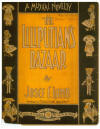
|
Joseph
Lamb. The Lilliputian's Bazaar: A
Musical Novelty. Toronto,
ON: HH Sparks, 1905.
[view
sheet music]
Source: Personal copy [top]
|
|
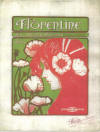
|
Joseph Lamb. Florentine: Valse.
Toronto, ON: HH Sparks, 1906.
[view
sheet music]
Source: Toronto
Reference Library Special
Collections [top]
|
|
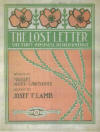
|
Josef F Lamb. The Lost Letter:
She Tho't Him False, He, Her Untrue
(words by Margret Anga Cawthorpe).
Toronto, ON: HH Sparks, 1907.
[view
sheet music]
Source: Toronto
Reference Library Special
Collections [top]
|
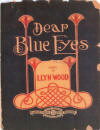 |
Joseph
Lamb. Dear Blue Eyes: True Eyes
(words by Llyn Wood). Toronto,
ON: HH Sparks, 1908.
[view
sheet music]
Source: Personal photocopy
from Pat Lamb Conn [top]
|
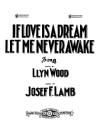 |
Joseph
Lamb. If Love is a Dream Let Me
Never Awake (words
by Llyn Wood). Toronto,
ON: HH Sparks, 1908.
[view
sheet music]
Source: Personal photocopy
provided by Pat Lamb Conn [top]
|
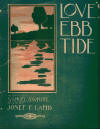 |
Josef
Lamb. Love's Ebb Tide
(words by Samuel White) (Toronto, ON: HH
Sparks, 1908).
[view
sheet music]
Source: University
of Toronto Music Library
[top]
|
 |
Josef
Lamb. Three Leaves of Shamrock on
the Watermelon Vine (words
by Harry Moore) (Toronto, ON: HH Sparks,
1908).
[view
sheet music]
Source: Photocopy from Library
and Archives Canada
[top]
|
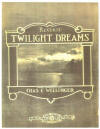 |
Joseph Lamb, arranger (composition by Charles Wellinger).
Twilight Dreams: Reverie (Toronto,
ON: HH Sparks, 1908).
[view
sheet music]
Source: University
of Toronto Music Library [top]
|
 |
Joseph
Lamb. The Homestead Where the
Suwanee River Flows (words
by Joseph Lamb) (Toronto, ON: HH Sparks,
1909).
[view
sheet music]
Source: Photocopy from Library
and Archives Canada
[top]
|
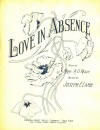 |
Joseph
Lamb. Love in Absence
(words by M.A. O'Reilly) (Gordon Hurst,
1909).
[view
sheet music]
Source: Personal copy
provided by Pat Lamb Conn [top]
|
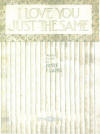 |
Joseph
Lamb. I Love you Just the Same
(words by Joseph Lamb) (Toronto, ON: HH
Sparks, 1910).
[view
sheet music]
Source: Toronto
Reference Library Special
Collections [top]
|
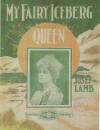 |
Joseph
Lamb. My Fairy Iceberg Queen
(words by Murray Wood) (Toronto, ON: HH
Sparks, 1910).
[view
sheet music]
Source: Toronto
Reference Library Special
Collections [top]
|
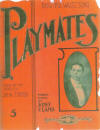 |
Joseph
Lamb. Playmates: Waltz Song
(words by Will Wilander) (Toronto, ON:
HH Sparks, 1910).
[view
sheet music]
Source: Personal photocopy
provided by Pat Lamb Conn [top]
|
b)
"Canadian" compositions believed to be written
by Joseph Lamb using a known pseudonym
In Joe Lamb: A Study of
Ragtime’s Paradox, the 1977 thesis
from the University of Cincinnati (55-56), Joseph
Scotti recounts a December 28, 1975, interview he
had with Amelia Lamb, wife of Joseph Lamb, about
his use of the pseudonyms "Harry Moore" and "Earl
West." The reason Sparks published compositions by
Joseph Lamb using these pseudonyms was to give the
impression he had more composers under contract
than he actually did (a common tactic by other
sheet music publishers). As such, it is believed
that Joseph Lamb is the composer of the pieces
below. In fact, Scotti
(1977:18) writes that Amelia Lamb gave him a copy
of In the Shade of the Maple by the Gate
(below) by "Earl West," it
being a composition by her husband). Of note, all
of the pieces are published by HH Sparks except
for The Ladies' Aid Song (1913) (below), which was published in
Toronto by Musgrave Bros & Davies "on behalf
of the composer." One possible explanation for
this is that HH Sparks is thought to have gone out
of business around 1910; as such, Sparks would not
have been able to publish this piece. It is
reasonable to surmise that Lamb had shopped the
piece around and eventually had it published "on
his behalf" by Musgrave Bros & Davies. As far
as I know, I am the first person to document the
possibility that The Ladies' Aid Song is
a "lost Lamb" composition.
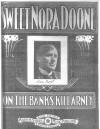 |
Moore,
Harry (likely pseudonym for Joseph Lamb).
Sweet Nora Doone. Toronto,
ON: Harry H Sparks, 1907.
[view
sheet music]
Source: British Library [top]
|
 |
Moore,
Harry (likely pseudonym for Joseph Lamb).
The Engineer's Last Good Bye.
Toronto, ON: HH Sparks, 1908.
[view
sheet music]
Source: Library
and Archives Canada
[top]
|
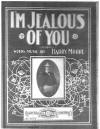 |
Moore,
Harry (likely pseudonym for Joseph Lamb).
I'm Jealous of You. Toronto,
ON: Harry H Sparks, 1908.
[view
sheet music]
Source: British Library [top]
|
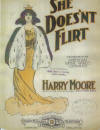 |
Moore,
Harry (likely pseudonym for Joseph Lamb).
She Doesn't Flirt. Toronto,
ON: Harry H Sparks, 1908.
[view sheet
music]
Source: Toronto Reference
Library Special Collections [top]
|
|
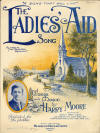
|
Moore, Harry
(likely pseudonym for Joseph Lamb). The
Ladies' Aid Song. Toronto, ON:
Musgrave Bros & Davies, 1913.
[view
sheet music]
Source:Library
and Archives Canada
[top]
|
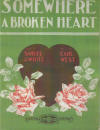 |
West, Earl
(likely pseudonym for Joseph Lamb). Somewhere
a Broken Heart (words by
Samuel Alexander White). Toronto, ON:
Harry H Sparks, 1908.
[view
sheet music]
Source: Toronto Reference
Library Special Collections [top]
|
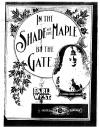 |
West, Earl
(likely pseudonym for Joseph Lamb). In
the Shade of the Maple by the Gate
(words by Ruth Dingman). Toronto, ON:
Harry H Sparks, 1908.
[view sheet
music]
Source: Toronto Reference
Library Special Collections [top]
|
c)
Joseph Lamb's Classic Rags published by Stark [top]
Between
1908 and 1919, Joseph Lamb published 12 classic
rags with John Stark, the ragtime publisher of Scott Joplin and James Scott. The Joseph
Lamb "Stark" rags below are all in the public
domain and are set out below.
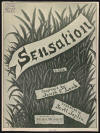 |
Joseph
Lamb. Sensation: A Rag. New
York: Stark Music Company, 1908.
Copyrighted: 8 October 1908.
[view
sheet music]
Source: Cover from Library
of Congress, Music Division
[top]
|
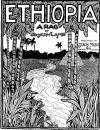 |
Joseph Lamb. Ethiopia Rag.
New York: Stark Music Company, 1909. Not
copyrighted.
[view
sheet music] [top]
|
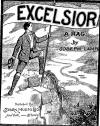 |
Joseph Lamb. Excelsior Rag.
New York: Stark Music Company, 1909. Not
copyrighted.
[view
sheet music] [top]
|
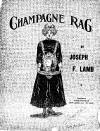 |
Joseph Lamb. Champagne Rag.
St Louis, MO: Stark Music Company, 1909.
Copyrighted 15 September 1910.
[view
sheet music] [top]
|
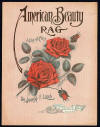 |
Joseph
Lamb. American Beauty Rag.
St Louis, MO: Stark Music Company, 1913.
Copyrighted 27 December 1913.
[view
sheet music] [top]
|
|
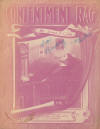
|
Joseph
Lamb. Contentment Rag. St
Louis, MO: Stark Music Co, 1915.
Copyrighted 10 January 1915.
[view
sheet music]
Source: Indiana
University Sheet Music Collections
[top]
|
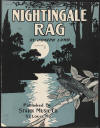 |
Joseph
Lamb. The Ragtime Nightingale.
St Louis, MO: Stark Music Company, 1915.
Copyrighted 10 June 1915.
[view
sheet music]
Source: Cover from Library
of Congress, Music Division [top]
|
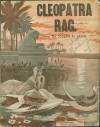 |
Joseph Lamb. Cleopatra Rag.
St Louis, MO: Stark Music Co, 1915.
Copyrighted 16 June 1915.
[view
sheet music]
Source: Indiana
University Sheet Music Collections
[top]
|
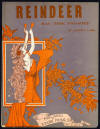 |
Joseph
Lamb. Reindeer: Ragtime Two Step.
St Louis, MO: Stark Music Company, 1915.
Not copyrighted.
[view
sheet music] [top]
|
|
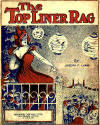
|
Joseph
Lamb. Top Liner Rag (St
Louis, MO: Stark Music Company, 1916).
Copyrighted 4 January 1916.
[view
sheet music]
Source: Warren
Trachtman [top]
|
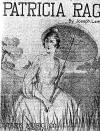 |
Joseph
Lamb. Patricia Rag. St
Louis, MO: Stark Music Company, 1916.
Copyrighted 19 November 1916.
[view
sheet music] [top]
|
|
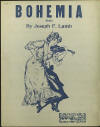
|
Joseph
Lamb. Bohemia Rag. New
York: Stark Music Co, 1919. Copyrighted 17
February 1919.
[view sheet
music]
Source: University
of Colorado Digital Sheet Music
Collection [top]
|
d) Joseph F Lamb, Ragtime Treasures Piano
Solos (New York: Mills Music, 1964) [top]
This now
out-of-print folio was published shortly after
Lamb's death and contains 13 previously
unpublished rags by Lamb, most of them written
during the ragtime era and revised or updated
right until the composer's death. These works
likely remain protected by copyright. The Table of
Contents, in alphabetical order, is as follows:
- Alabama
Rag
- Arctic
Sunset
- Bird
Brain Rag
- Blue
Grass Rag
- Chimes
of Dixie
- Cottontail
Rag
- Firefly
Rag
- Good
and Plenty Rag
- Hot
Cinders
- The
Old Home Rag
- Ragtime
Bobolink
- Thorough
Bred Rag
- Toad
Stool Rag
e)
Joseph F Lamb, Brown Derby #2, a.k.a.
Untitled Rag (St Louis, MO: Penny 3,
Robinson & Wells Inc, nd).
This
composition, a previously unpublished rag made
available by Joseph Lamb's daughter, was available
for purchase from the online store of the Scott Joplin
International Ragtime Foundation, but as of
October 2016 it is not clear if it is still
available.
f)
Joseph F Lamb, Ragtime Reverie
(St Louis, MO: Penny 3, Robinson & Wells Inc,
nd).
This
composition, a previously unpublished rag made
available by Joseph Lamb's daughter, was available
for purchase from the online store of the Scott Joplin
International Ragtime Foundation, but as of
October 2016 it is not clear if it is still
available.
g) Joseph
F Lamb, A Little Lost Lamb: Piano Music by
Joseph F Lamb (Oak Forest, IL: Ragtime
Press, 2005) [top]
This wonderful folio
of previously unpublished rags and songs
by Joseph Lamb is available for purchase
from Ragtime
Press, PO Box 630, Oak Forest, IL
60452 (Attention: Sue Keller). Sue
Keller has recorded a CD of the pieces
(with some of the vocals sung by
Patricia Lamb Conn, a daughter of the
composer). Both are highly recommended.
These works remain protected by
copyright. The Table of Contents, in
alphabetical order, is as follows:
- The Alaskan Rag
(1959)
- The Beehive Rag
(1959)
- Chasin' the Chippies
(1914)
- Gee, Kid! But I Like
You (1909) [published 1909,
Shapiro Music, NY?]
- Greased Lightening
Rag (1959)
- I Want to Be a
Bird-Man (1913)
- I'll Follow the Crowd
to Coney (1913)
- The Jersey Rag
(1959)
- Joe Lamb's Old Rag
(1959)
- Lorne Scots on Parade
(1904)
- Mignonne (1901)
- My Queen of Zanzibar
(1904)
- Ragged Rapids Rag
(1905)
- The Rag-Time Special
(1959)
- Rapid Transit
(1959)
- Red Feather
(1906)
- Spanish Fly
(1912)
- Walper House Rag
(1903)
|
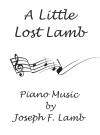 |
h)
Four recently re-discovered pieces [top]
The
following four pieces by Joseph Lamb, thought to be
lost, were recently rediscovered and are available
for purchase online here
- Joseph
F Lamb. Cinders
- Joseph
F Lamb. Shooting the Works
- Joseph
F Lamb. Chime In
- Joseph
F Lamb. Crimson Rambler
i)
Unpublished Compositions by Joseph F Lamb
[top]
The 1977
University of Cincinnati dissertation by Joseph
Scotti entitled Joe Lamb:
a Study of Ragtime’s Paradox (273-85)
contains a list of works by Joseph Lamb. In his
thesis, Scotti identifies the following additional
compositions possibly by Joseph Lamb not already
included above:
| Title |
Date
Composed |
Sent
to Library of Congress |
|
Meet
Me at the Chutes |
1900 |
4
September 1961 |
|
Idle
Dreams |
1900 |
August
1962 |
|
Lenonah |
1901 |
August
1962 |
|
Dora
Dean's Sister |
1902 |
August
1962 |
|
Muskoka
Falls, "Indian Idyll" |
1902 |
4
September 1961 |
|
Golden
Leaves (Canadian Concert Waltzes) |
1903 |
4
September 1961 |
|
Le
Premier - French Canadian March |
1903 |
4
September 1961 |
|
Midst
the Valleys of the Far off Golden West |
1903 |
August
1962 |
|
When
the Winter is Over |
1903 |
February
1962 |
|
The
Ivy Covered Homestead on the Hill |
1904 |
4
September 1961 |
|
Tell
Me that You Will Love Me as I Love You |
1904 |
4
September 1961 |
|
The
Eskimo Glide |
1905 |
4
September 1961 |
|
Florida |
1905 |
August
1962 |
|
A
Rose and You |
1905 |
February
1962 |
|
My
Little Glow Worm |
1905 |
August
1962 |
|
Sourdough
March |
1906 |
August
1962 |
|
Samuel
Coon Song |
1908 |
4
September 1961 |
|
Dear
Old Rose |
1909 |
4
September 1961 |
|
Let's
Do It Again |
1912 |
February
1962 |
|
A
Little Girl Like You |
1913 |
4
September 1961 |
|
Romance
Land |
1913 |
February
1962 |
|
That
Wonderful Melody |
1914 |
February
1962 |
|
Wal-Yo (words
by Mrs Joseph Lamb) |
1914 |
August
1962 |
|
I'd
Give the World to Have You Back Again |
1915 |
February
1962 |
|
Just
for You |
1915 |
October
1962 |
|
For
the Cause of Liberty |
1916 |
August
1962 |
|
Oh!
You with Hair Like Mine |
1916 |
October
1962 |
|
Love
me Like I Like You |
1926 |
4
September 1961 |
|
It
Breaks My Heat to Leave You Melie Dear |
1959 |
4
September 1961 |
|
Wanda |
? |
October
1961 |
|
Only
You |
? |
October
1962 |
|
The
22nd Regiment March |
? |
October
1962 |
|
Ilo-Ilo |
? |
October
1962 |
|
The
Dying Hero |
? |
October
1962 |
|
She's
My Girl (Intro Playmates) |
? |
? |
|
I'd
Like You to Love Me |
? |
? |
|
I
Should Have Known |
? |
? |
|
Since
You Took Your Heart Away |
? |
? |
|
I'm
Going to Go Somewhere |
? |
? |
|
Don't
You Be Lonely |
? |
? |
|
Our
Emperor |
? |
? |
|
Our
Empire |
? |
? |
|
Nemesis |
? |
? |
Scotti (1977:278) also
mentions the following titles from a list held by
Ragtime Bob Darch as possibly being compositions
by Lamb:
- Jennie
Song
- Farewell
My Love
- Cheese
It
- Down
in Dear Old Florida
- In
Gay Old Golden Gate
Scotti
also lists the following three pieces as being
published; these pieces are also contained in
Keller's A Little Lost Lamb. If Scotti is
correct, as he is with the first title below, then
these three pieces are likely in the public domain
as being pre-1923:
|
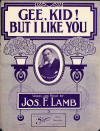
|
Joseph
Lamb, Gee, Kid! But I Like You
(New York: Maurice Shapiro, 1909).
[view
sheet music]
Source: Library
of Congress, Music Division [top]
|
| |
Joseph Lamb, I Want to Be a
Bird-Man (Brooklyn, NY: G
Satterlee, Satterlee Music Company,
1913).
Available from A
Little Lost Lamb, above.
|
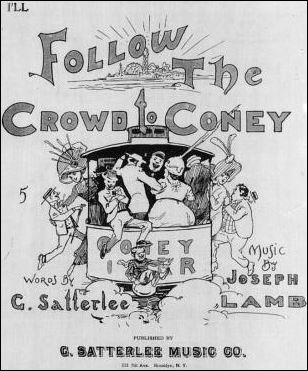 |
Joseph Lamb. I'll Follow the
Crowd to Coney (words by G
Satterlee) (Brooklyn, NY: G Satterlee,
Satterlee Music Company, 1913).
Available from A
Little Lost Lamb, above.
|
There is
some discussion in the ragtime literature that
Joplin and Lamb collaborated on a composition
circa 1910 and that a piece entitled Scott
Joplin's Dream is the result. However, most
scholars now doubt that is the case – see, for
example, Scotti 1977:46.
"Perfessor"
Bill Edwards lists the following two compositions
as being co-written by Lamb with Gus Collins, an
in-law:
- Purple
Moon (1930)
- So
Here We Are
Finally,
journalist Mary Jukes in a July 20, 1963, Globe &
Mail newspaper story at page 15
entitled "Designers Collect Music in
Ragtime" mentions Joseph Lamb who "went to school
in Berlin (now Kitchener) and composed such
old-time pieces as The Humber Rag and The
Muskoka Rag." In 2006 when I was writing
this essay, this was the only mention I had
uncovered of possible Lamb compositions entitled The
Humber Rag and The Muskoka Rag,
although Scotti does mention Lamb as a possible
composer of Muskoka Falls, "Indian Idyll"
(1902), which is also mentioned as being composed
by Lamb in the
"Rivers in Canadian Music" entry in the
Encyclopedia
of Music in Canada (an entry which,
among other things, discusses Canadian music on
the theme of rivers). In the Fall of 2006, the
composer's daughter provided me with a photocopy
of a handwritten, unpublished manuscript called
Muskoka Falls, "Indian Idyll."
4)
Recommended Commercial Recordings of Joseph Lamb
Compositions [top]
Set out
below are some of the better compact disc (CD)
recordings of Lamb's compositions. Below this list
are links to a number of MIDI
recordings available on the Internet,
recorded by various artists.
- Arpin,
John. Champagne Rags (ProArte –
Feb 1993):
- Sensation:
A Rag
- Ethiopia
- Contentment
Rag
- Topliner
Rag
- Cleopatra
Rag
- Champagne
Rag
- American
Beauty Rag
- Reindeer
Ragtime Two-Step
- Ragtime
Nightingale
- Excelsior
Rag
- Patricia
Rag
- Bohemia
- Eskin,
Virginia. American Beauties: The Rags of
Joseph Lamb (Koch Int'l Classics,
May 2000) [Amazon
entry]
- Walper
House Rag
- The
Alaskan Rag
- Ragtime
Reverie
- Brown
Derby No 2
- Alabama
Rag
- Arctic
Sunset
- Bird-Brain
Rag
- Cottontail
Rag
- Hot
Cinders
- Ragtime
Bobolink
- The
Old Home Rag
- Firefly
Rag
- Thoroughbred
Rag
- Toad
Stool Rag
- Sensation
- Ethiopia
- Excelsior
- American
Beauty Rag
- Patricia
Rag
- Nightingale
Rag
- Keller,
Sue. A Little Lost Lamb (with
vocals on select songs by Patricia Lamb Conn)
(Oak Forest, IL: Ragtime Press, 2005)
[see: http://www.rtpress.com/lamb.htm]
- Jersey
Rag
- Chasin'
the Chippies
- Greased
Lightening Rag
- Mignonne
- Gee,
Kid! But I Like You
- Lorne
Scots on Parade
- Rapid
Transit
- I
Want To Be A Birdman
- Red
Feather
- Ragged
Rapids Rag
- Walper
House Rag
- My
Queen of Zanzibar
- Beehive
Rag
- Joe
Lamb's Old Rag
- Ragtime
Special
- Spanish
Fly
- Follow
the Crowd to Coney
- Alaskan
Rag
- Cottontail
Rag
- Excelsior
Rag
- Cleopatra
Rag
- Meeting
with Scott Joplin
- Sensation
– A Rag
- Arthur
Marshall, Artie Mathews, James Scott
- Topliner
Rag
- Alaskan
Rag, The
- The
Composition of "Nightingale"
- Ragtime
Nightingale, The
- American
Beauty Rag
- The
Naming of Contentment
- Contentment
Rag
- Patricia
Rag
- Nielson,
Guido. Complete Stark Rags of Joseph F
Lamb (Basta Records) [Amazon
entry]
- Teck,
Kath. On Track! Ragtime Music of Joseph
Lamb [Amazon
entry]
MIDI
Recordings of Joseph Lamb Compositions
There are
a number of MIDI recordings of Lamb compositions
available on the Internet:
5) Bibliography on Joseph Lamb [top]
In 2006,
when first writing this essay, I tried to compile
below the most complete bibliography of books and
articles about Joseph Lamb. This bibliography was
created through a combination of my own index
searches and by consulting the various
bibliographies in books on ragtime. I have not
been able to obtain copies of every item in the
bibliography below so have not been able to verify
every entry (but I hope to do so some day).
Readers are encouraged to consult Carol
Binkowski's book (listed below).
- Balliet,
Whitney. "Ragtime Game." (2 July 1960) New
Yorker 20-21.
- Blesh, Rudi & Harriet
Grossman Janis. 1966. They All Played
Ragtime, 4th ed. New York: Oak
Publications [Internet Archive version].
- Blesh,
Rudi, "Notes on an American Genius." Foreword to
Joseph F Lamb, Ragtime Treasures Piano
Solos. New York: Mills Music, 1964.
- Borgman,
GA. "Joseph F Lamb, Classic Ragtimer" (Aug 2001)
28 The Mississippi Rag 1-2.
- Borgman,
GA. "Joseph F Lamb, Classic Ragtimer, Part 2"
(Sept 2001) 28 The Mississippi Rag 23-27.
- Cassidy, Russ. 1961.
"Joseph Lamb: Last of the Ragtime
Composers" (1961) 7 Jazz Monthly (August,
1961), 4-7; (October, 1961), 12-15; (November,
1961), 9-10; (January, 1962), 1-6; (February,
1962), 1-4; (March, 1962), 1-3' (April, 1962),
7-8.
- Charters,
Samuel. 1960. "Notes on Joseph Lamb: A Study
in Classic Ragtime," Folkways FG 5363
[liner notes].
- "The
Compositions of Joseph F Lamb." (January 1963) 2
Ragtime Society 5-6.
- Eccles,
William. "Mr Ragtime Comes Home: After 50 Years,
Ragtime's Pioneer Makes a Canadian Comeback." The
Toronto Star Weekly (21 November 1959).
- Freilich-Den,
Marjorie. Joseph F Lamb, A Ragtime Composer
Recalled (Thesis, Brooklyn College, CUNY,
1975).
- Hutton,
Jack. 1984. "Chatting with Amelia" (Nov-Dec
1984) The Ragtimer.
- "Inside
Stuff – Music." (7 October 1959) 216 Variety
65.
- Jasen, David & Trebor Jay
Tichenor. Rags and Ragtime: A Musical
History. New York: Dover Publications,
1978 at 122-133.
- "Joseph
Francis Lamb Dies" (1961) Second Line No
3-4, 15.
- Jukes, Mary. "Designers
Collect Music in Ragtime" (20 July 1963) Globe
& Mail 15. [articles mentions Joseph
Lamb who "went to school in Berlin (now
Kitchener) and composed such old-time pieces as
The Humber Rag and The Muskoka Rag"].
- Massey,
D. "Unifying Characteristics in Classic Ragtime"
(Fall 2001) 22 Indiana Theory Review
27-50.
- McCarthy, Eugene. "Joseph
F Lamb: Ragtime Great Started Composing at
Kitchener, Ontario" (21 October 1974) The
Kitchener-Waterloo Record. Reprinted in
(November/December 1974) The Ragtimer 19.
- Montgomery,
Mike. "A Visit with Joe Lamb" (December 1957) 19
Jazz Report.
- Montgomery,
Mike. "Joseph F Lamb: A Ragtime Paradox,
1887–1960" (1961) Second Line No 3-4,
17–18.
- Morriss, Frank. "Visit in
a Rainswept Cemetery: Ragtime Composer Recalls a
Debt" (8 October 1959) Globe & Mail 15.
- Morriss,
Frank. "What's This? A Cult Among Ragtime Fans"
(14 October 1959) Globe & Mail 22.
- (Obituary):
6 Jazz Monthly (December, 1960), 16; Jazz
Report, I (October, 1960), 12; Variety,
CCXX (September 28, 1960), 79.
- "Rag
Composer Remembered" (Jan-Feb 1979) The
Ragtimer 4-5.
- "Ragtime
Aids United Appeal" (3 October 1959) Globe
& Mail 16 [describes efforts
by Bob Darch to raise money to bring Joseph Lamb
and his wife to a ragtime benefit in Toronto].
- Schafer,
William. "Joseph F Lamb: 'Sensation." (September
1975) 2 Mississippi Rag, 6-7.
- Schafer, William &
Johannes Riedel. 1973. The Art of Ragtime:
Form and Meaning of an Original Black American
Art. Baton Rouge, LA: Louisiana State
University Press [Internet Archive version].
- Scotti, Joseph. Joe
Lamb: A Study of Ragtime’s Paradox
(Dissertation, University of Cincinnati, 1977).
- Tichenor,
Trebor Jay. "The World of Joseph Lamb: An
Exploration." 7 Jazz Monthly (August,
1961), 7-9; (October, 1961), 15-17; (November,
1961), 10-11; (December, 1961), 16-17.
- Wilkes, Galen. "The Black
Lamb of the Family: Joseph F Lamb's Minstrel
Shows" Vol 1 The Ragtime Ephemeralist. Excerpt
available online.
[top]
|
|
